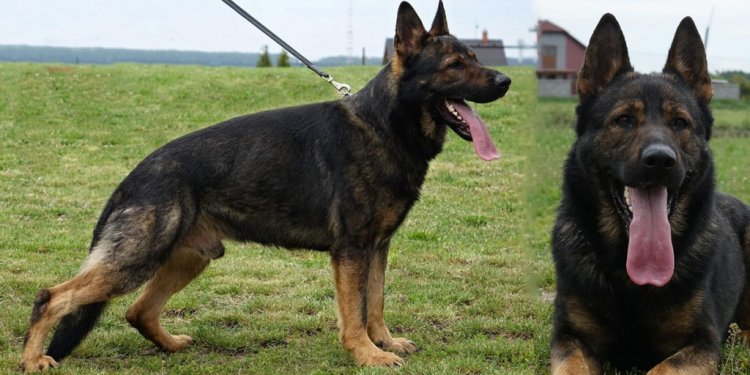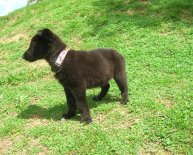
Czechoslovakian German Shepherd
In earlier posts I mentioned that the breed has many varieties and types consistent with the standard of the breed and that in some cases it is possible to identify their place of origin by their physical characteristics. In this article I will name a few I know of, just to illustrate the point.
A couple of the most common ones are the German Shepherd dogs of German lines and the German Shepherd dogs of American lines. I have already explained the main differences in structure and temperament between these two lines on another post, so I will not bore you with their description again. If you are interested, you can check my post from December 6th 2009; “”.
A few other lines that fall in this category are:
East German Lines (DDR)
They were developed in the German Democratic Republic (Deutshe Demokratishe Republik) informally called East Germany, from those dogs that remained in the East after World War II.
The DDR was a socialist state, which was established in 1949 in the Soviet zone of occupied Germany and in the portion of East Berlin which was occupied by the Allied forces. Geographically, it consisted of northeast Germany rather than all of eastern Germany. Its dissolution began with the fall of the Berlin Wall on November 9, 1989 and ended in October 1990 with the German reunification. It has been 20 years since the reunification of Germany. However, even today a divide still exists between the German Shepherd bloodlines recovered after the World War II.
The DDR no longer exists today, but the DDR German Shepherd Dog still does, although in my opinion it’s a “dying breed”. Before the fall of the Berlin Wall, East German dogs were kept isolated from West German dogs and because of that, they retained their own distinct characteristics. Although they came from the same original stock before the war, the division prevented the mixing of bloodlines and they developed fairly differently. Nowadays German Shepherd dogs of pure East German Lines are pretty rare and many lines are extinct.
True DDR bloodlines are limited to four decades of breeding in former East Germany, but their bloodlines may be found in the pedigrees of German Shepherds around the world today.
DDR dogs have a strong, solid, lean, muscular body, heavy bone structure and a large massive head. They have dark pigmentation and are not as angulated as West German show dogs. These dogs have a strong temperament, great working ability and are well suited for Schutzhund, police work, search and rescue and many other tasks. Most importantly, DDR German Shepherds have a very low incidence and severity of hip dysplasia.
German Shepherd Dog of East German Lines (DDR)
Czechoslovakian Lines (Czech)
They were bred in communist Czechoslovakia as state working dogs. These dogs were mostly developed from DDR lines and are essentially the same.
Czechoslovakia existed as a sovereign state from 1918 to 1992. In 1939 though, Czechoslovakia was forcefully divided and partially incorporated to Nazi Germany, and this lasted until 1945, when the Soviet Union took over the eastern part of Carpathian Ruthenia, which later became part of the Slovak Republic. From 1939 to 1945 the state didn’t really exist, although the Czechoslovakian government did continue to exist in exile. On January 1st 1993 Czechoslovakia peacefully split into the Czech Republic and Slovakia.
Before the revolution in Czechoslovakia and the fall of their communist government in 1989, German Shepherds bred in Czechoslovakia were primarily working dogs used for the protection of their borders. What is exceptional is that their breeding was done in just one kennel founded in 1955, which was owned by the Czechoslovakian Army's Border Patrol. The dogs used for breeding were acquired mostly from the East Germany (DDR) and the breeding program focused on solid nerves, working ability, strong bones and dark pigmentation.
The DDR and Czechoslovakia were members of the Soviet Bloc and they both developed working bloodlines to be used as assistance to border guards and as police protection dogs. Because of the close affiliation between the two, both lines are pretty much the same bloodline.
German Shepherd Dog of Czechoslovakian Lines (Czech)
British Lines (Alsatians)
These lines are descendants of old lines that were imported into the British Isles before the post-war German lines.
Around 1908 the first German Shepherds arrived in Great Britain. In 1917, after America entered World War I, everything associated with Germany acquired a negative connotation. The American Kennel Club changed the name of the breed from the German Shepherd dog to the Shepherd Dog. Meanwhile in England, the breed was renamed Alsatian, after the French-German border area of Alsace, Lorraine. The name Alsatian was never really used anywhere else, except for England, and it was changed back to the German Shepherd dog in 1977.
These dogs developed a little differently than German Shepherds from other areas. They have heavier bone structure, a long body type, uniform shoulders and an even top line. They come in a variety of colors, being black and tan, black and red, sable, bi color and black the most common.





